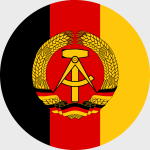Hobby Master HG3309 East German T-55 Main Battle Tank - Europe, 1980's (1:72 Scale)
"It seems that the most important thing about Reagan was his anti-Communism and his reputation as a hawk who saw the Soviet Union as an 'evil empire.'"
- Mikhail Gorbachev reflecting on the Reagan Administration's policies during the 1980s
 The T-54 and T-55 main battle tanks were the Soviet Union's replacements for the World War II era T-34 tank. The T-54/55 tank series is the most numerous in the world, and very widely employed, especially by former client states of the Soviet Union.
The T-54 and T-55 main battle tanks were the Soviet Union's replacements for the World War II era T-34 tank. The T-54/55 tank series is the most numerous in the world, and very widely employed, especially by former client states of the Soviet Union.
The T-54 and T-55 tanks are very similar and difficult to distinguish visually. Many T-54s were updated to T-55 standards. Soviet tanks were factory-overhauled every 7,000 km, and often given minor technology updates. Many states have added or modified tank equipment (India affixed fake fume extractors to its T-54s and T-55s, so that Indian gunners wouldn't confuse them with Pakistani Type 59s).
The T-54 can be distinguished by a dome-shaped ventilator on the turret front-right, and has a SGMT 7.62 mm machine gun in a fixed mount in the front of the hull, operated by the driver. Early T-54s lacked a gun fume extractor, had an undercut at the turret rear, and a distinctive "pig-snout" gun mantlet. The T-55's new turret has large D-shaped roof panels, visible from above.
This particular 1:72 scale replica of a T-55 tank served with the East German Army during the 50's and 60's.
Sold Out!
Dimensions:
Length: 4-inches
Width: 1-1/2-inches
Release Date: June 2009
Historical Account: "Serpents" - At the end of World War II, the Western allies and the USSR divided much of the world amongst themselves. Germany was no exception. The country was split into four occupation zones, which later evolved into two separate and increasingly antagonistic countries: West Germany, an ally of the West, and Communist East Germany, the right hand of the Soviet Union. Both sides evaded cease-fire agreements aimed at blocking the two Germanys from developing armed forces.
With the help of the Soviets, East Germany formed police groups of various sorts -- ground, air, water and others -- to circumvent these restrictions. By the early 1950s, these police groups had expanded to the size of small armies, each with its own administrative and mission tasks. By then the Cold War had escalated into a struggle for survival between two global power blocs, with the Soviets backing their new client state, the GDR (German Democratic Republic; in German, DDR), as it became more open in its demands for a genuine military.
In 1956, East Germany merged existing police units into recognizable armed forces: infantry, air force, navy, and other branches. In this confrontational way the East Germans began their formidable military machine -- all geared for total war against the West, including their West German blood brothers, whenever the call came from Berlin or, more accurately, from Moscow.
In 1987, the armed forces of the DDR, officially known as the National People's Army (NVA - Nationalen Volksarmee), totaled 175,300 troops, of whom slightly over half (54%) were conscripts. The NVA comprised four main branches: ground forces, Navy, Air Force/Air Defense, and Border Guards, who technically were under the control of the Ministry of Defense, but in the field cooperated closely with the ground forces.
The actual number of male and female soldiers under arms was much larger, however, than the figure above indicates. East Germany's Communist leaders followed the Soviets in having available an assortment of auxiliary forces with military capabilities to support the regime. The list includes several types of police, militia, para-military and special mission units.
It is vital to note that these forces were subordinate to Soviet forces stationed in East Germany, which numbered 380,000 men organized into 20 infantry divisions and one air army. In addition to countering NATO, the Soviets placed so many troops in the DDR to ensure internal security and to keep the East Germans from rising up against their larger Communist brother.


